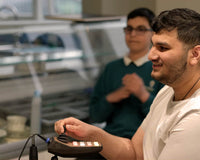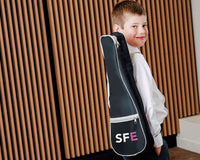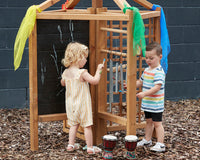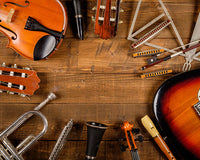You may have thought that piano playing is all about how fast you move your fingers over all the keys. Or how well you keep the rhythm and hit all the right notes... Well yes, you are right! But not everyone thinks about how to use their feet on the pedals. Not one to miss out on creating wonderful piano music, the pedals can play a big part in your pieces. In this blog, I am going to explain how your feet can help improve your playing.
If you look at a standard acoustic piano, you often see 3 gold/chrome pedals on the floor, linked up to the main instrument by a selection of metal rods and other gizmos. You probably won’t start working on the pedals until about Grade 4/5, but it is always good to have a bit of background knowledge on what they do, and how they work. Let’s go from left to right…
The Soft Pedal
The first pedal we come across is classed as the “Soft” pedal. This is mainly used when playing certain expressive pieces where you need to “soften” the blow when the hammers hit the strings. So, imagine you are playing a steady piece of music on an upright piano, but just need to “round off” the note at the end of a section. When you depress the pedal, a thin layer of felt is positioned between the wooden hammers and the piano strings. When you strike the note, the hammer will hit the string and the sound will be dampened by the felt. Therefore, making the note play “softly”. I wonder how they named that pedal?
The Sostenuto Pedal
This pedal takes a bit of time and practice to mastering. Named
Sostenuto, the idea behind it is to create a bit of variation in pieces. It is designed to sustain only the notes that you are holding down when the pedal is depressed. Therefore, if used correctly, it should give you a piece which has quick use of the sustain, but the rest of the piano is unaffected. The reason why I say it takes practice to master is because you need to have super-fast reflexes in order to sustain the right notes and not the entire keyboard. Once you've cracked it though, it offers a whole new playing experience. Let’s see how long it takes me to get it!
The Sustain Pedal
Probably one of the most used pedals on the piano, the Sustain lets you add dramatic effect, pauses and more to your pieces. It uses a similar mechanism to the Sostenuto pedal, but instead of holding certain notes, it holds all of them. For example, on an acoustic piano, when the pedal is depressed the dampers move away from the strings. When you play a note, the hammer hits the string and allows it to vibrate freely. It is a clever piece of technology really, as when the pedal is not in use, the dampers will stop the string(s) from vibrating.
Pedals At Normans
We do stock a good selection of different pedals, here at
Normans, that you can use alongside your digital piano/keyboard. You may notice that they are mainly all classed as “Sustain Pedals”, but usually within the keyboard settings, it does give you the option of what you want the pedal to do; sustain, soft, volume etc.

Our top pick pedal would be the Y
amaha FC4 Piano Style Sustain Pedal, compatible with most Yamaha pianos and keyboards. It provides great response and a comfortable feel whilst remaining very stable to ensure the pedal doesn't slip away whilst playing.

Alternatively, if you have a digital piano which can work with a pedal board,
take a look at those. Featuring all 3 pedals, it gives you the same feel you would get playing an acoustic piano. Our top pick pedal board would be
Yamaha LP-255 Pedal Board. This easy to fit pedal board can fit 3 pedals allowing you to play more advanced musical pieces.
I hope this has given you a brief insight into how different piano pedals work; if you have any more questions or need further information, please feel free to get in touch with us. You can email us via
sales@normans.co.uk or give us a call on 01283 535 333!
 Our top pick pedal would be the Yamaha FC4 Piano Style Sustain Pedal, compatible with most Yamaha pianos and keyboards. It provides great response and a comfortable feel whilst remaining very stable to ensure the pedal doesn't slip away whilst playing.
Our top pick pedal would be the Yamaha FC4 Piano Style Sustain Pedal, compatible with most Yamaha pianos and keyboards. It provides great response and a comfortable feel whilst remaining very stable to ensure the pedal doesn't slip away whilst playing.
 Alternatively, if you have a digital piano which can work with a pedal board, take a look at those. Featuring all 3 pedals, it gives you the same feel you would get playing an acoustic piano. Our top pick pedal board would be Yamaha LP-255 Pedal Board. This easy to fit pedal board can fit 3 pedals allowing you to play more advanced musical pieces.
I hope this has given you a brief insight into how different piano pedals work; if you have any more questions or need further information, please feel free to get in touch with us. You can email us via sales@normans.co.uk or give us a call on 01283 535 333!
Alternatively, if you have a digital piano which can work with a pedal board, take a look at those. Featuring all 3 pedals, it gives you the same feel you would get playing an acoustic piano. Our top pick pedal board would be Yamaha LP-255 Pedal Board. This easy to fit pedal board can fit 3 pedals allowing you to play more advanced musical pieces.
I hope this has given you a brief insight into how different piano pedals work; if you have any more questions or need further information, please feel free to get in touch with us. You can email us via sales@normans.co.uk or give us a call on 01283 535 333!



















